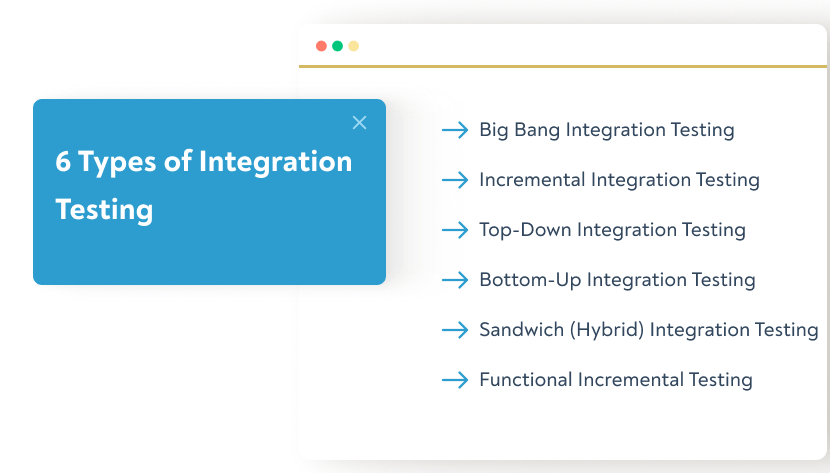What is integration testing?
Integration testing checks the interaction between different modules or components of a software application to ensure they work together as expected. It is a process of combining individual units and testing them as a group to identify interface defects and issues with data flow.
Sometimes QA professionals confuse integration testing with the others, so let’s also clarify what it is not.
What Integration Testing is Not:
- Unit Testing: Integration testing is not the same as unit testing. The latter focuses on testing individual components in isolation to ensure they function correctly on their own. We’ll touch on this comparison in more detail in the end.
- System Testing: It also differs from system testing. System testing is checking the entire system to verify that it meets the specified requirements.
- Acceptance Testing: Integration testing is not the same as acceptance testing either. You conduct the latter to determine whether the system satisfies the acceptance criteria and is ready for deployment.
By understanding these distinctions, you can better appreciate the unique value of integration testing. But what makes integration testing so special? Let’s look at the importance of this testing together.
Integration is a very loaded term. By definition it’s how two independent things work together. Unit testing tests code in isolation, meaning any api call, any database call, any call to a different module are all mocked out. Integration is testing that code without the mocks to see how they work together.
The importance of integration testing
According to various studies, the lack of proper integration testing can lead to significant project failures:
- Studies by Forbes (2016) and BCG (2020) found that almost 85% of all digital integration efforts end in partial or total failure.
- Research also shows that big projects that require huge data integration have a failure rate 50% higher than smaller projects.
- Another study by McKinsey-Oxford in 2012 reported even more frightening stats: 17% of large projects had gone so badly that they threatened the existence of the companies involved.
So what do these stats teach us? First, proper integration testing could be a lifesaver for your company. Second, as the data you need to integrate gets larger, integration testing becomes a necessity. A robust integration testing helps you identify and resolve these interface defects and compatibility problems early, reducing the risk of horrific consequences mentioned above.
Integration Testing Types
There are several main types of integration testing, each with its own advantages and disadvantages:
Big Bang Integration Testing
Big Bang Integration Testing involves integrating all components or modules simultaneously after they have been individually developed. With this approach, you test the entire system at once, so you can comprehensively examine the integrated components. However, this method can lead to significant challenges in defect isolation and issue resolution as simultaneous integration is too complex.
Advantage: The primary benefit is that it allows you to do a thorough end-to-end test of the complete system. This is specifically efficient for simpler projects.
Disadvantage: The major drawback is that you’ll face difficulties in identifying specific defects since all components are integrated at once. It might result in late discovery of critical issues.
Incremental Integration Testing
Incremental integration testing involves integrating and testing modules one by one. It ensures that each module works correctly before moving on to the next. This method helps you identify and fix defects earlier, as you test each integrated module independently before adding new modules.
Advantage: The key advantage is the ease of defect isolation and resolution, as you detect and address issues separately.
Disadvantage: The step-by-step integration is time-consuming. It requires detailed planning and sequencing that might not be suitable when working within tight deadlines.
Top-Down Integration Testing
Top-down integration testing starts with integrating and testing the high-level modules first, followed by the lower-level modules. It helps you with early testing of major system control points and decision-making processes, as you ensure that the core functionalities are validated first.
Advantage: The benefit of this approach is the early detection of interface issues and major control points. This way, you identify high-level problems earlier.
Disadvantage: It requires the creation of stubs for lower-level modules, which can be complex, and delays the testing of lower-level components until later.
Bottom-Up Integration Testing
Bottom-Up Integration Testing involves integrating and testing lower-level modules first, followed by the higher-level modules. This way, you focus on ensuring that foundational components work correctly before testing their interactions with higher-level modules.
Advantage: You test the lower-level modules and their interactions before integrating them into the higher levels, with no need for stubs.
Disadvantage: The approach delays the testing of higher-level modules, which may push back the identification of defects in top-level interactions.
Sandwich (Hybrid) Integration Testing
Sandwich integration testing combines both top-down and bottom-up approaches, testing all modules at once. It provides you with a balanced approach by addressing both high-level and low-level interactions.
Advantage: The main benefit is that you comprehensively test high-level and low-level modules with a balanced strategy for complex systems.
Disadvantage: It requires careful planning and coordination, adding to the complexity of the testing process.
Functional Incremental Testing
Functional incremental testing focuses on integrating and testing modules based on their functionality, addressing one feature or functionality at a time. This method allows for targeted testing of specific features as they are integrated. With this approach, you validate the key functionalities early.
Advantage: The advantage is the early identification of defects related to specific functionalities.
Disadvantage: It takes significant effort and time to create and manage test cases for each functional increment.

These various integration testing types serve only one purpose: making sure the software and its different modules work smoothly. And for this purpose, you need a helping hand that will streamline different phases of not only integration testing, but your overall testing efforts.
Here comes aqua cloud – an AI-powered test management system that has been serving different businesses for 20 years. Bringing German quality to the software testing, aqua helps your integration testing efforts like this:
- Creating and Structuring Unit Tests: aqua helps you efficiently create and organise unit tests. These tests serve as the building blocks for integration testing. After this, you’ll be able to validate individual components before integration. This systematic and organised approach to testing helps you maintain clarity and focus.
- Managing Test Scenarios: With aqua, you can compile these unit tests into comprehensive test scenarios. This feature allows you to check the integration between individual units seamlessly. This way, you ensure all interactions between components are tested thoroughly and reduce the risk of integration issues.
- Comprehensive Test Management: aqua cloud provides a centralised platform for managing all aspects of your integration testing. From test creation to execution and reporting, you can oversee the entire process in one place. This way, you ensure nothing falls through the cracks.
- Enhanced Collaboration: aqua cloud improves collaboration among your team members by providing a shared repository for test management. With aqua, everyone is on the same page, reducing misunderstandings and improving the overall quality of your integration testing.
That is not the whole picture. aqua goes beyond the integration testing efforts and provides you with these unique features:
- AI-driven software testing cycle: With aqua, you can generate requirements, test cases, and test data with just 3 clicks, all taking a few seconds.
- 100% traceability: aqua helps you ensure there is no gap in your requirements management and you can always track the progression of each.
- Seamless bug-reporting: Another blow to the misunderstandings between the QA and dev teams – aqua’s integration with Capture (visual bug tracking tool) makes sure you create the most visually appealing proofs of discovered bugs.
Combining everything above, aqua aims at one thing only: taking away the pain of testing from you. So what are you waiting for?
Do not limit yourself to integration testing: streamline 100% of your testing efforts instead
Should You Automate the Integration Testing?
This question might sound formal, as automation is becoming a cornerstone in software testing. Different researches show that 78% of successful businesses benefit from automated testing, as automating your testing efforts boosts defect detection by 90%.
The inevitability of automated testing is clear, but the question remains: why and when should you automate your integration testing?
Let’s look at some key points on how automation helps you in integration testing efforts:
- Efficiency and Speed:
- Automation can significantly speed up your testing process. Instead of manually running tests, automated scripts can handle repetitive tasks quickly and accurately.
- Automating integration tests ensures you can execute them consistently, reducing human error and saving valuable time.
- Consistency and Reliability:
- Automated tests run the same way every time and ensure consistent results. This reliability is crucial for detecting integration issues that might slip through manual testing.
- Consistent test execution means you can trust your results and confidently move forward with development.
- Cost-Effectiveness:
- While initial setup costs for automation is high, the long-term savings are evident. You can reuse and run automated tests as many times as needed without additional cost.
- Investing in automation can reduce the need for extensive manual testing, freeing up your team to focus on more complex tasks.
- Comprehensive Test Coverage:
- Automation allows you to achieve more extensive test coverage. You can run a broader range of tests, including those that are too time-consuming to execute manually.
- With comprehensive coverage, you ensure that every aspect of your integration is thoroughly tested, catching potential issues early.
- Scalability:
- As your project grows, so does the complexity of integration testing. Automation provides a scalable solution. It allows you to handle increasing numbers of tests without proportional increases in time and effort.
- Scalable testing ensures your system remains robust, even as it evolves.
Challenges of Automation:
- Despite the benefits, automation isn’t without its challenges. Setting up automated tests requires a significant initial investment in time and resources.
- Maintenance of automated tests is also demanding, particularly if your system undergoes frequent changes. You need to update the tests regularly to remain effective.
- When to Automate:
- Automation is ideal for repetitive, high-volume tasks you need to run frequently. If your integration tests fall into this category, automation can be a game-changer.
- However, not all tests are suitable for automation. Complex scenarios that require human judgement or are run infrequently might be better suited to manual testing.
According to Capgemini, organisations realise significant benefits from test automation at various stages of the testing cycle. Integration testing stands out as really valuable, as it accounts for 45% of the benefits, just behind development (48%), requirements (47%), and functional testing (46%).
So what result do we derive from this? Automation is helpful, no doubt. However, it’s essential to weigh the advantages against the initial setup and ongoing maintenance costs. You should carefully consider your specific needs and resources, and then determine the best approach to integrating automation into your testing strategy.
Want to get a precise strategy based on your skillset, budget, and deadlines? Here is an interactive simulation that delivers it to you, fully customised:
🎯 Integration Testing Decision Engine (Click to open)
Build your personalized integration testing strategy in minutes
Best Practices for Integration Testing
Following best practices can make a significant difference in the efficiency and effectiveness of your integration testing efforts. Let’s explore some of the key strategies that can help you get the most out of your integration testing efforts:
- Plan and Prioritise Tests: Start by identifying the critical integration points and prioritise your testing efforts accordingly. Focus on areas that have the highest risk of failure or that are most crucial to your application’s functionality. Having a clear plan helps you cover all necessary integration scenarios without overlooking important aspects.
- Use Realistic Test Data: Include data that closely mimics what your system will encounter in a live environment. This helps you identify potential issues that might not occur with synthetic or overly simplified data. Realistic data leads to more accurate test results and better prepares your system for real-world usage.
- Automate Where Possible: Use automation tools to handle repetitive and time-consuming integration tests. We’ve already stated above why and when you should do it.
- Perform Continuous Integration: Integrate code changes frequently and run integration tests as part of your continuous integration (CI) pipeline. This way, you detect and fix integration issues earlier.
- Isolate and Test Separately: Instead of integrating and testing all components at once, isolate individual modules and test them separately. It will be easier to identify and resolve issues at specific integration points.
- Review and Refine Test Cases: As your application evolves, your test cases should evolve with it to cover new features and integration points. That is why regular reviews and updates are crucial.
These best practices will help you improve the reliability, efficiency, and effectiveness of your testing efforts. But without knowing the challenges of the process, you won’t be able to apply these practices. What challenges? Let’s break them down next.
Challenges of Integration Testing
Integration testing is critical but comes with its own set of challenges. Here are the four main challenges you might face:
- Complexity of Dependencies: Managing and testing the interactions between various components is a complex process. Each module might depend on others, creating a web of dependencies that need to be carefully orchestrated.
- Environment Management: Ensuring that the test environment accurately reflects the production environment is crucial but also challenging. Differences in configuration, data, or even software versions can lead to inconsistent test results. IBM reports that 30% of all integration testing issues stem from discrepancies between test and production environments.
- Data Handling and Management: Handling and managing the vast amounts of data required for thorough integration testing can be daunting. Ensuring data integrity and consistency across tests is essential to avoid false positives or negatives.
- Continuous Integration Pressure: With the rise of CI practices, there is immense pressure to integrate and test code changes rapidly. This can lead to rushed testing processes, increasing the risk of missed defects.
By understanding these challenges, you can develop a more robust understanding and strategy for effective integration testing.
Entry and Exit Criteria of Integration Testing
Setting clear entry and exit criteria is essential for smooth integration testing. These criteria help you start and finish integration testing effectively and completely. Here’s a streamlined look at what you should check:
Entry Criteria:
- Test Environment Ready: Confirm that the test environment is correctly set up and closely represents the production environment.
- Modules Integrated: Verify that all modules are integrated and working as expected before beginning the tests.
- Test Data Ready: Have realistic test data prepared to simulate real-world scenarios and cover all necessary cases. (aqua cloud can help you with that!)
- Test Plan Approved: Make sure the integration test plan, including all test cases and scenarios, is reviewed and approved.
Exit Criteria:
- Complete Test Coverage: Check that all planned integration test cases have been executed and integration points are thoroughly tested.
- Defects Addressed: Confirm that all major and critical defects found during testing have been resolved.
- System Stability: Test that the integrated system performs reliably and meets performance expectations under normal conditions.
- Results Documented: Make sure that test results are reviewed and all documentation is complete and accurate.
Knowing these criteria will help you with a more structured, nearly complete approach. Before we finalise the article, let’s point out the differences between integration testing and 2 different testing types.
Unit Testing vs Integration Testing: What Are the Differences?
Imagine you are a part of a QA team working on a new feature for a web application. Here’s how you handle unit testing versus integration testing:
- Unit Testing: Your team begins by focusing on a specific function, like a discount calculator for the checkout process. You create unit tests to ensure this function works correctly in isolation, testing various inputs and edge cases. Unit testing is about verifying that each individual component functions as intended on its own.
- Integration Testing: After the discount function is validated, the team tests how this function interacts with other parts of the checkout system, such as the cart and payment processing. Integration testing ensures that different components of the system work together seamlessly.
Differences:
- Focus: Unit testing focuses on the functionality of individual components, while integration testing is concerned with how those components interact with each other.
- Scope: Unit tests are narrower, testing isolated pieces of code. Integration tests are broader, covering interactions between multiple components.
- Objective: The goal of unit testing is to catch errors in individual functions or methods. Integration testing aims to identify issues that arise when combining components.
Integration Testing vs End-to-End Testing
Now, consider your team testing an entire e-commerce platform:
- Integration Testing: The team tests the interaction between the user login module and the profile management system. You check if users can log in and if their profile data is updated and retrieved correctly. Integration testing focuses on verifying that different modules work together properly.
- End-to-End Testing: The team performs end-to-end testing by simulating the entire user journey. This includes browsing products, adding items to the cart, checking out, and receiving a confirmation email. End-to-end testing ensures that the complete system functions correctly from start to finish.
Differences:
- Focus: Integration testing looks at how specific modules work together, while end-to-end testing assesses the complete workflow of the application.
- Scope: Integration testing deals with interactions between individual components. End-to-end testing covers the entire application process.
- Objective: Integration testing aims to find issues in the connections between modules, whereas end-to-end testing seeks to validate that the overall user experience is seamless and functioning as intended.
These comparisons help you clarify the distinct roles of each, but all of them serve the same purpose: delivering high-quality software with minimum to no bugs or crashes. And that is where you need aqua cloud.
aqua cloud, an AI-powered test management software with 20 years of experience, enhances your testing process in several key ways:
- Efficient Unit Test Creation and Management: aqua helps you create and organise unit tests seamlessly, serving as the foundation for integration testing.
- Streamlined Test Scenarios: You can compile unit tests into comprehensive scenarios to ensure thorough integration checks and minimise issues.
- Centralised Test Management: aqua helps you oversee the entire testing process from creation to reporting in one platform, ensuring nothing is overlooked.
- Enhanced Team Collaboration: aqua provides a shared repository for test management, improving coordination and reducing misunderstandings.
Additionally, aqua offers AI-driven test management, 100% traceability, and AI-Copilot for support. This means you’re just a few clicks away from completely transforming your testing efforts. The question is, are you ready for this?
Use the 100% power of AI in your integration testing efforts
Final words
In this guide, we dived into the critical role of integration testing with you, covering its various types, best practices and the challenges involved. Now, you’re also equipped to identify key differences between unit, integration, and end-to-end testing, and understand how each contributes to a robust software development process. The theoretical part is perfect. Now onto the practical part: are you ready to streamline your testing efforts and achieve superior results? Contact us and let us answer this question for you.


















